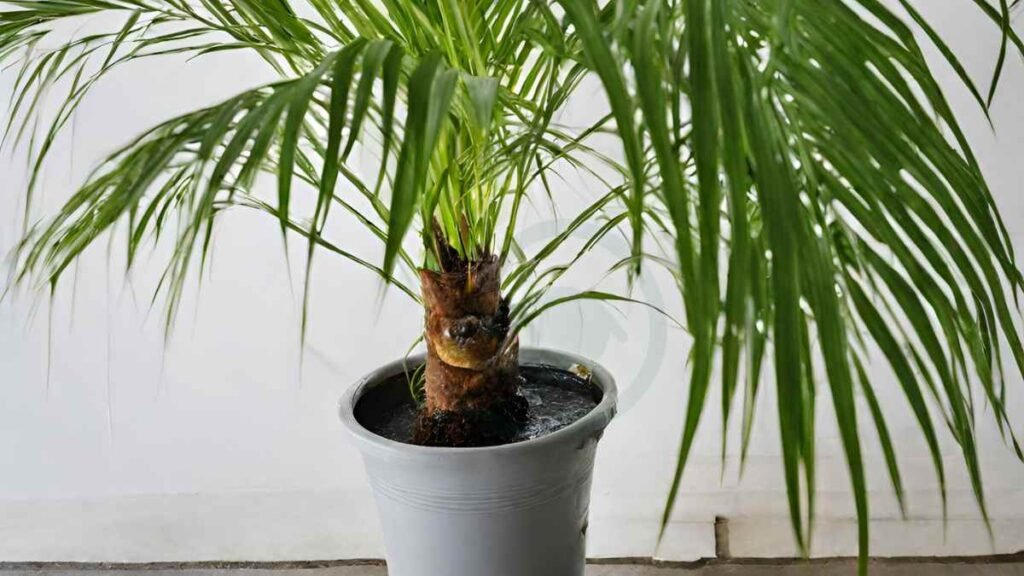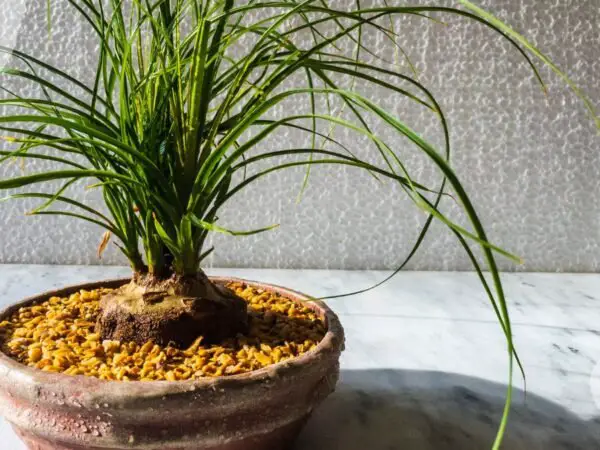Areca Palm watering is essential for maintaining the health and vitality of your plant. With proper care, you can ensure your Areca Palm, a houseplant, thrives in its environment.
To properly water your Areca Palm and ensure good drainage for the roots, it's crucial to strike a balance. Over-watering can lead to root rot, while under-watering can cause the leaves to turn brown and fall off. A general rule of thumb is to water your Areca Palm when the top inch of soil feels dry to the touch. During warmer months, you may need to water more frequently, while in cooler months, you can reduce watering frequency. Additionally, using filtered or distilled water can help prevent mineral buildup in the soil, which can harm the plant.
For more tips on caring for your Areca Palm and ensuring its optimal growth, stay tuned for additional insights on proper lighting, fertilization, and pest control.
Key Takeaways
- Proper watering is crucial: Ensure your areca palm receives the right amount of water to thrive.
- Use the right tools: Invest in essential watering tools like a watering can with a narrow spout for accurate watering.
- Master watering techniques: Understand the watering needs of your areca palm and adjust based on its environment.
- Avoid common mistakes: Overwatering can be detrimental, so monitor the soil moisture and drainage carefully.
- Follow care tips: Implement proper care practices like regular misting and providing adequate sunlight for optimal growth.
- Monitor for pests and issues: Keep an eye out for pests and troubleshoot growth problems promptly.
Areca Palm Basics

About Areca Palm
Areca palm originates from subtropical regions, showcasing feathery, arching fronds that add elegance to any space. This plant thrives under bright, indirect light conditions.
Ideal Soil Conditions
Maintaining an optimal soil pH of 6-6.5 is crucial for the areca palm's health. Experts recommend a loam-based soil mixed with sand to enhance nutrient intake and improve drainage.
Light Requirements
The areca palm prefers bright, indirect light, making it ideal for east or west-facing windows during the summer months. In winter, move the plant to a south-facing window to ensure adequate sunlight exposure.
Essential Watering Tools
Plant Mister
Mist leaves weekly to eliminate dust accumulation, aiding in maximizing photosynthesis and maintaining overall leaf health.
Watering Can
Utilize rain or distilled water for watering to avoid exposing the plant to harmful chemicals, ultimately enhancing areca palm health.
Soil Tester
Employ the finger test method to assess soil moisture levels accurately, ensuring the appropriate watering frequency and preventing overwatering issues.
Watering Techniques

Frequency Tips
Water once every ten days to maintain proper moisture levels for the areca palm. Adjust this frequency to weekly watering in summer when the plant requires more hydration due to higher temperatures. In contrast, decrease watering to bi-weekly intervals during winter when the plant's growth slows down.
Volume Guidelines
When watering, ensure you dilute fertilizer with plenty of water to avoid nutrient concentration that might harm the plant. This practice not only prevents root scorching but also maximizes nutrient absorption by the areca palm, promoting healthy growth and vibrant foliage.
Seasonal Adjustments
Make seasonal adjustments to your watering routine based on the areca palm's needs. Increase watering in summer to accommodate the plant's increased water requirements due to higher evaporation rates. Conversely, decrease watering in winter when the plant enters a dormant phase. It is essential to align your watering schedule with the plant's growth cycle for optimal health and vitality.
Proper Watering Method

Step-by-Step Guide
Water once every ten days to maintain optimal moisture levels for the areca palm. This frequency ensures the plant receives adequate hydration without being overwatered.
Use rain or distilled water to avoid mineral buildup in the soil, which can harm the plant over time. These types of water are gentler on the plant and help prevent leaf browning.
Fertilize monthly during growing season to provide essential nutrients for healthy growth. Choose a balanced fertilizer specifically formulated for palms to support lush foliage and vibrant appearance.
Checking Soil Moisture
Utilize a soil & light tester to accurately assess the moisture level in the potting mix. This tool helps you determine whether it's time to water the areca palm based on soil conditions.
Perform a finger test by inserting your finger into the soil up to two inches deep. If the soil feels dry at this depth, it's an indication that the plant requires watering.
Ensure that the soil is dry before watering again to prevent root rot and other issues caused by excessive moisture. Overly wet soil can lead to fungal problems and compromise the plant's health.
Common Watering Mistakes
Overwatering Signs
Overwatering can lead to yellow leaves or soggy stems, indicating excess moisture in the soil. This can result in a risk of root rot, which hinders the plant's ability to absorb nutrients properly. To combat this issue, adjust watering frequency by allowing the soil to dry out slightly between waterings.
Underwatering Signs
Signs of underwatering include dry, crispy leaves that may turn brown and fall off prematurely. You may notice stunted growth in the plant due to insufficient water intake. To address this problem, consider increasing watering frequency to ensure the plant receives an adequate amount of moisture.
Areca Palm Care Tips
Fertilizing Needs
Areca palms require monthly fertilization with an NPK blend rich in nitrogen to support healthy growth. This helps prevent nutrient deficiencies and ensures the plant thrives.
Regular fertilization is crucial to promote optimal growth and vibrant foliage. It is recommended to use a balanced fertilizer high in nitrogen.
To avoid issues like stunted growth or yellowing leaves, ensure the nutrient levels are maintained through consistent fertilization. This practice supports the overall health of the plant.
Pruning Practices
Pruning plays a vital role in maintaining the aesthetics and health of your areca palm. Regular pruning should be done to remove any dead or damaged parts of the plant.
By trimming away dead fronds, you not only enhance the appearance of the palm but also stimulate new growth. This promotes a lush and full-looking plant.
Maintaining the shape of your areca palm through pruning is essential for its overall appearance and health. It helps in controlling its size and encourages a well-balanced growth pattern.
Pest Management
Identifying Pests
Regularly check for pests on your areca palm by inspecting the leaves and stems closely. Look for common pests like spider mites, mealybugs, and aphids. Treat any infestations promptly to prevent them from spreading to other plants in your home. Maintaining the overall health of the plant is crucial in preventing pest problems.
Using Neem Oil
Consider using neem oil as a natural option for controlling pests on your areca palm. It is safe for plants and effective against many common pests like spider mites and aphids. Neem oil works by suffocating the pests and disrupting their life cycle, helping to keep your plant healthy.
Growth Troubleshooting
Slow Growth Causes
Insufficient light can stunt the growth of areca palms, hindering their development and overall health. Ensure adequate sunlight exposure to promote optimal growth.
Nutrient deficiency, especially in essential elements like nitrogen and potassium, can significantly impact the growth rate of areca palms. Regularly fertilize the soil to provide necessary nutrients for healthy growth.
Incorrect watering frequency, either too much or too little water, can impede the growth of areca palms. Establish a consistent watering schedule based on the plant's needs to support robust growth.
Leaf Discoloration
Adjusting the soil pH is crucial if the leaves of areca palms start turning yellow. Use acidifying agents to lower the pH level and restore leaf color to a healthy green.
Monitor for nutrient deficiencies by observing any unusual discoloration or patterns on the leaves. Address any deficiencies promptly through appropriate fertilization or soil amendments.
Ensuring proper watering practices, such as avoiding waterlogged soil or allowing the soil to dry out completely, is vital in preventing leaf discoloration in areca palms. Maintain optimal moisture levels for healthy foliage.
Additional Care Tools
Dust Cloth Usage
Regularly dust leaves using a soft cloth to keep them clean and free from dust particles. This simple task aids in enhancing photosynthesis by allowing maximum light absorption. By doing so, you improve plant health and overall growth.
Bug Killer Application
Utilize natural bug killers like neem oil or insecticidal soap to combat pests without harming the environment. Avoid harmful chemicals that can damage the plant and disrupt its growth cycle. Prioritize safe solutions to effectively protect plant health in the long run.
Closing Thoughts
By now, you have gained a comprehensive understanding of how to properly water your areca palm to ensure its optimal growth and health. Remember the essential tools needed, the correct techniques to employ, and the common mistakes to avoid. Implementing these strategies will undoubtedly contribute to the well-being of your plant. Integrating proper care tips, effective pest management, and troubleshooting growth issues will further enhance the longevity and vibrancy of your areca palm.
Take charge of your plant's well-being by applying the knowledge you have acquired. Consistent care and attention are key to fostering a thriving areca palm in your indoor space. Now that you possess this valuable information, go ahead and put it into practice to enjoy a lush and flourishing addition to your home décor.
Frequently Asked Questions
How often should I water my Areca Palm?
Water your Areca Palm thoroughly when the top inch of soil feels dry. Typically, this means watering every 1-2 weeks, depending on environmental conditions and season. Ensure proper drainage to prevent root rot.
Can I use tap water for my Areca Palm?
Yes, you can use tap water for your Areca Palm. However, if your tap water is high in salts or chemicals, it's recommended to let the water sit overnight to allow these substances to dissipate before watering your plant.
What are common mistakes to avoid when watering an Areca Palm?
Avoid overwatering as it can lead to root rot. Ensure proper drainage by using a pot with drainage holes. Don't let the plant sit in standing water. Also, steer clear of underwatering, which can cause the tips of the leaves to turn brown.
Should I mist my Areca Palm in addition to regular watering?
While misting can increase humidity around your Areca Palm, it's not necessary for its well-being. Focus on consistent watering practices rather than misting. If you live in a dry climate or notice browning leaf tips, consider increasing humidity through other methods like a humidifier.
How do I know if my Areca Palm is getting too much or too little water?
Monitor the soil moisture level by feeling the top inch of soil. Yellowing fronds may indicate overwatering, while brown tips could signal underwatering. Adjust your watering frequency accordingly based on these visual cues and the moisture level of the soil.
Is it better to underwater or overwater an Areca Palm?
It's better to slightly underwater than overwater an Areca Palm since it's more tolerant of drying out than sitting in soggy soil. Err on the side of caution and allow the soil to partially dry between waterings to prevent root rot and other issues related to overwatering.
Image Source: Paid image from CANVA





